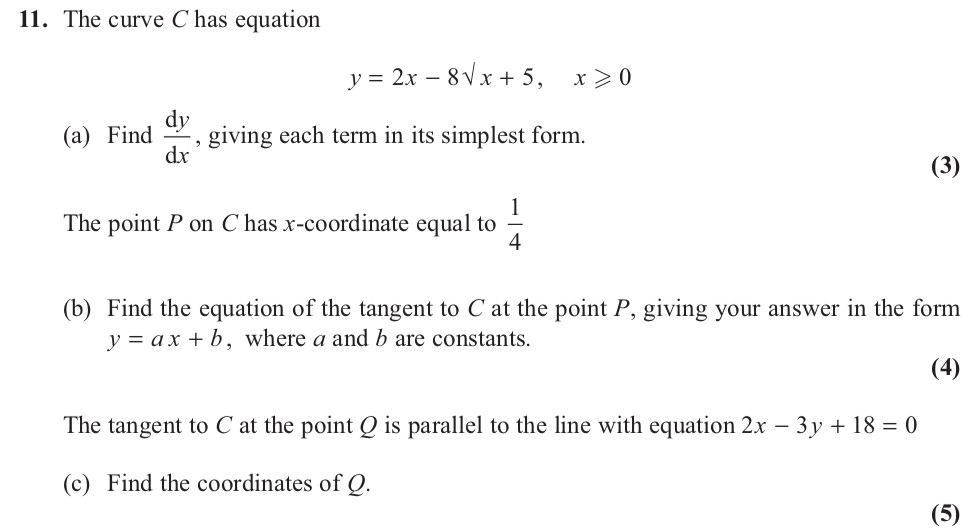Photo AI
The curve C has equation y = 2x - 8 sqrt{x} + 5, x > 0 (a) Find \(\frac{dy}{dx}\), giving each term in its simplest form - Edexcel - A-Level Maths Pure - Question 3 - 2013 - Paper 3
Question 3

The curve C has equation y = 2x - 8 sqrt{x} + 5, x > 0 (a) Find \(\frac{dy}{dx}\), giving each term in its simplest form. (3) The point P on C has x-coordinate eq... show full transcript
Worked Solution & Example Answer:The curve C has equation y = 2x - 8 sqrt{x} + 5, x > 0 (a) Find \(\frac{dy}{dx}\), giving each term in its simplest form - Edexcel - A-Level Maths Pure - Question 3 - 2013 - Paper 3
Step 1
Find \(\frac{dy}{dx}\), giving each term in its simplest form.
Answer
To find (\frac{dy}{dx}), we need to differentiate the equation of the curve:
Given: [ y = 2x - 8\sqrt{x} + 5 ]
Differentiating term by term, we have:
- The derivative of (2x) is (2).
- The term (-8\sqrt{x}) can be rewritten as (-8x^{1/2}). Therefore, its derivative is: [-8 \cdot \frac{1}{2}x^{-1/2} = -4x^{-1/2}]
- The derivative of a constant, (+5), is (0).
So we combine these results: [ \frac{dy}{dx} = 2 - 4x^{-1/2} ]
In simplest form, this is: [ \frac{dy}{dx} = 2 - \frac{4}{\sqrt{x}} ]
Step 2
Find the equation of the tangent to C at the point P, giving your answer in the form \(y = ax + b\), where a and b are constants.
Answer
First, we find the gradient at point P where (x = \frac{1}{4}):
Substituting (x = \frac{1}{4}) into our derivative: [ \frac{dy}{dx} = 2 - 4\left(\frac{1}{4}\right)^{-1/2} = 2 - 4 \cdot 2 = 2 - 8 = -6 ]
Thus, the gradient at P is (-6).
Now, we need to find the coordinates of point P by substituting (x = \frac{1}{4}) back into the original curve equation: [ y = 2\left(\frac{1}{4}\right) - 8\sqrt{\frac{1}{4}} + 5 = \frac{1}{2} - 4 + 5 = \frac{1}{2} + 1 = \frac{3}{2} ]
Point P has coordinates (\left(\frac{1}{4}, \frac{3}{2}\right)).
Using the point-slope form of the equation of a line, the equation of the tangent line is:
[ y - \frac{3}{2} = -6\left(x - \frac{1}{4}\right) ]
Expanding this gives: [ y = -6x + \frac{3}{2} + \frac{3}{2} = -6x + 3 ]
So the equation of the tangent line in the required form is: [ y = -6x + 3 ]
Step 3
Find the coordinates of Q.
Answer
The slope of the line (2x - 3y + 18 = 0) can be rearranged to the gradient-intercept form: [ 3y = 2x + 18 \Rightarrow y = \frac{2}{3}x + 6 ]
Thus, the gradient of this line is (\frac{2}{3}).
Since the tangent at Q is parallel to this line, it too has a gradient of (\frac{2}{3}).
We already know that the general point Q on the curve C will also satisfy the curve equation, so we set: [ \frac{dy}{dx} = \frac{2}{3} ]
Setting the derivative we found earlier equal to (\frac{2}{3}): [ 2 - \frac{4}{\sqrt{x}} = \frac{2}{3} ]
Rearranging gives: [ 2 - \frac{2}{3} = \frac{4}{\sqrt{x}} \Rightarrow \frac{6}{3} - \frac{2}{3} = \frac{4}{\sqrt{x}} \Rightarrow \frac{4}{3} = \frac{4}{\sqrt{x}} ]
Cross-multiplying these gives: [ 4\sqrt{x} = 4 \Rightarrow \sqrt{x} = 1 \Rightarrow x = 1 ]
To find the y-coordinate for Q, substitute back into the original curve equation: [ y = 2(1) - 8\sqrt{1} + 5 = 2 - 8 + 5 = -1 ]
Thus, the coordinates of Q are ((1, -1)).
